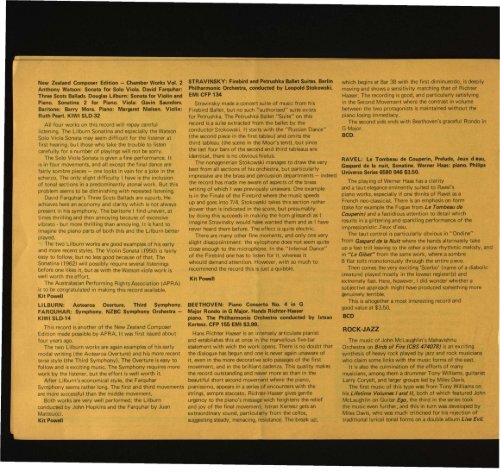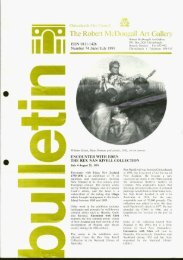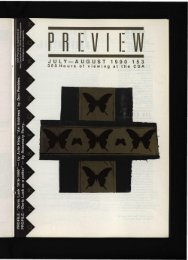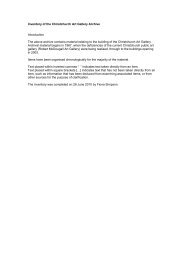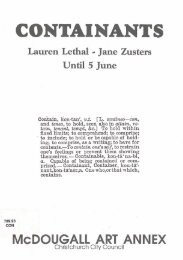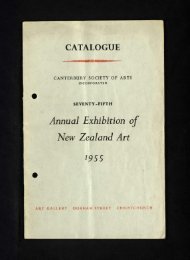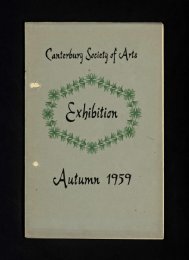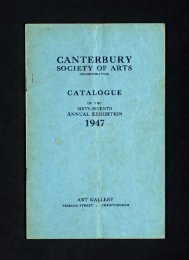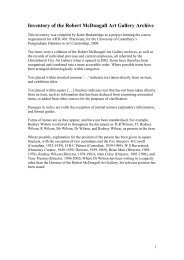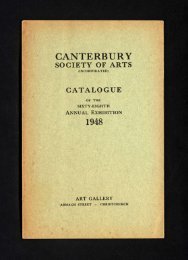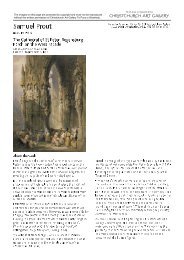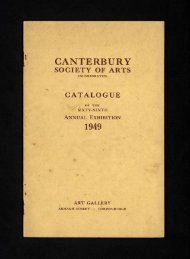Download (6.6 MB) - Christchurch Art Gallery Te Puna O Waiwhetu
Download (6.6 MB) - Christchurch Art Gallery Te Puna O Waiwhetu
Download (6.6 MB) - Christchurch Art Gallery Te Puna O Waiwhetu
- No tags were found...
You also want an ePaper? Increase the reach of your titles
YUMPU automatically turns print PDFs into web optimized ePapers that Google loves.
New Zealand Composer Edition — Chamber Works Vol. 2Anthony Watson: Sonata for Solo Viola. David Farquhar:Three Scots Ballads. Douglas Lilburn: Sonata for Violin andPiano. Sonatina 2 for Piano. Viola: Gavin Saunders.Baritone: Barry Mora. Piano: Margaret Nielsen. Violin:Ruth Pearl. KIWI SLD-32All four works on this record will repay carefullistening. The Lilburn Sonatina and especially the WatsonSolo Viola Sonata may seem difficult for the listener atfirst hearing, but those who take the trouble to listencarefully for a number of playings will not be sorry.The Solo Viola Sonata is given a fine performance. Itis in four movements, and all except the final dance arefairly sombre pieces — one looks in vain for a joke in thescherzo. The only slight difficulty I have is the inclusionof tonal sections in a predominantly atonaJ work. But thisproblem seems to be diminishing with repeated listening.David Farquhar's Three Scots Ballads are supurb. Heachieves here an economy and clarity which is not alwayspresent in his symphony. The baritone I find uneven, attimes thrilling and then annoying because of excessivevibrato - but more thrilling than annoying. It is hard toimagine the piano parts of both this and the Lilburn betterplayed.The two Lilburn works are good examples of his earlyand more recent styles. The Violin Sonata (1950) is fairlyeasy to follow, but no less good because of that. TheSonatina (1962) will possibly require several listeningsbefore one likes it, but as with the Watson viola work iswell worth the effort.The Australasian Performing Rights Association (APRA)is to be congratulated in making this record available.Kit PowellLILBURN: Aotearoa Overture. Third Symphony.FARQUHAR: Symphony. NZBC Symphony Orchestra -KIWI SLD 14This record is another of the New Zealand ComposerEdition made possible by APRA. It was first issued aboutfour years ago.The two Lilburn works are again examples of his earlymodal writing (the Aotearoa Overture) and his more recentterse style {the Third Symphony). The Overture is easy tofollow and is exciting music. The Symphony requires morework by the listener, but the effort is well worth it.After Lilburn's economical style, the FarquharSymphony seems rather long. The first and third movementsare more successful than the middle movement.Both works are very well performed; the Lilburnconducted by John Hopkins and the Farquhar by JuanMatteucci.Kit PowellSTRAVINSKY: Firebird and Petrushka Ballet Suites. BerlinPhilharmonic Orchestra, conducted by Leopold Stokowski.EMI CFP 134Stravinsky made a concert suite of music from hisFirebird Ballet, but no such "authorised" suite existsfor Petrushka. The Petrushka Ballet "Suite" on thisrecord is a suite extracted from the ballet by theconductor Stokowski. It starts with the "Russian Dance"(the second piece in the first tableu) and omits thethird tableau (the scene in the Moor's tent), but sincethe last four bars of the second and third tableaus areidentical, there is no obvious hiatus.The nonagenerian Stokowski manages to draw the verybest from all sections of his orchestra, but particularlyimpressive are the brass and percussion departments — indeed,the record has made me aware of aspects of the brasswriting of which I was previously unaware. One exampleis in the Finale of the Firebird where the music speedsup and goes into 7/4. Stokowski takes this section ratherslower than is indicated in the score, but presumablyby doing this succeeds in making the horn glissandi as Iimagine Stravinsky would have wanted tham and as I havenever heard them before. The effect is quite electric.There are many other fine moments, and only one veryslight disappointment: the xylophone does not seem quiteclose enough to the microphone. In the "Infernal Dance"of the Firebird one has to listen for it, whereas itwhould demand attention. However, with so much torecommend the record this is just a quibble.Kit PowellBEETHOVEN: Piano Concerto No. 4 in GMajor Rondo in G Major. Hands Richter-Haaserpiano. The Philharmonia Orchestra conducted by IstvanKertesz. CFP 155 EMI $3.99.Hans Richter Haaser is an intensely articulate pianistand establishes this at once in the marvellous five-barstatement with wich the work opens. There is no doubt thatthe dialogue has begun and one is never again unaware ofit, even in the more decorative solo passages of the firstmovement, and in the brilliant cadenza. This quality makesthe record outstanding and never more so than in thebeautiful short second movement where the piano,pianissimo, appears in a series of encounters with thestrings, sempre staccato. Richter-Haaser gives gentleurgency to the piano's message wich heightens the reliefand joy of the final movement. Istran Kertesz gets anextraordinary sound, particularly from the cellos,suggesting steady, menacing, resistance. The break up.which begins at Bar 38 with the first diminuendo, is deeplymoving and shows a sensitivity matching that of RichterHaaser. The recording is good, and particularly satisfyingin the Second Movement where the contrast in volumebetween the two protagonists is maintained without thepiano losing immediacy.The second side ends with Beethoven's graceful Rondo inG Major.BCD.RAVEL: Le Tombeau de Couperin, Prelude, Jeux d ftau,Gaspard de la nuit, Sonatine. Werner Haas: piano. PhilipsUniverso Series 6580 046 $3.50.The playing of Werner Haas has a clarityand a taut elegance eminently suited to Ravel'spiano works, especially if one thinks of Ravel as aFrench neo-classicist. There is an emphasis on form(take for example the Fugue from Le Tombeau deCouperin) and a fastidious attention to detail whichresults in a glittering and sparkling performance of theimpressionistic J'eux d'eau.The taut control is particularly obvious in "Ondine"from Gaspard de la Nuit where the hands alternately takeup a fast trill leaving to the other a slow rhythmic melody, andin "Le Gibet" from the same work, where a sombreB flat tolls monotonously through the entire piece.Then comes the very exciting 'Scarbo' (name of a diaboliccreature) played mostly in the lowest register(s) andextremely fast. Here, however, I did wonder whether asubjective approach might have produced something moregenuinely terrible.This is altogether a most interesting record andgood value at $3.50.BCDROCK-JAZZThe music of John McLaughlin's MahavishnuOrchestra on Birds of Fire (CBS 474078) is an excitingsynthesis of heavy rock played by jazz and rock musicianswho claim some links with the music forms of the east.It is also the culmination of the efforts of manymusicians, among them a drummer Tony Williams, guitaristLarry Coryell, and larger groups led by Miles Davis.The first music of this type was from Tony Williams onhis Lifetime Volumes I and II, both of which featured JohnMcLaughlin on Guitar Ego, the third in the series tookthe music even further, and this in turn was developed byMiles Davis, who was much criticised for his rejection oftraditional lyrical tonal forms on a double album Live Evil.


